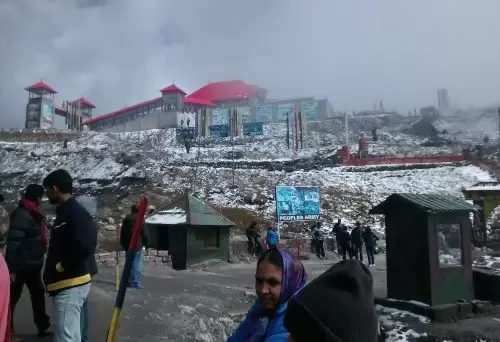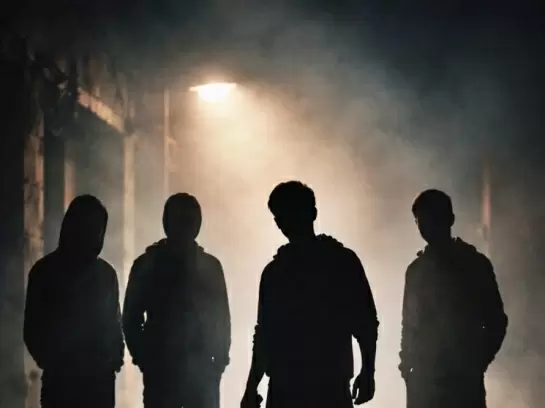Go up to Nathu La, the listening ears pass, and you might spot Chinese soldiers
26-October-2015
Vol 6 | Issue 43
Visiting Nathu La is no less than a pilgrimage, but not of the religious kind. At 14,420 feet above sea level, one is struck by the sheer history that surrounds this strategic mountain pass which connects the northeast Indian state of Sikkim to the Chumbi Valley in China's Tibet Autonomous Region.
An off-shoot of the famous Silk Road which networked trade routes since 500 BC, the "listening ears pass" or Nathu La is about nature, history, beauty and sheer ingenuity all rolled into one.
 |
|
At Nathu La, Indian tourists can spot Chinese soldiers across the border (Photo: IANS)
|
No amount of preparation can get one ready to travel to the historic pass. For an uninitiated like me, it was a trip that opened my eyes wider.
The overcast skies only added to the chill when we set off from Gangtok, the capital of Sikkim, in an SUV at 8.30 a.m. The next four hours that followed made for one of the most unforgettable trips I have ever undertaken.
Just 54 km from Gangtok, Nathu La was a nodal point for commerce and exchange of knowledge between India, China and rest of the world. If history isn't what draws attention, the sights are enough to captivate your imagination.
As the stomach churning drive began, the Himalayan mountain range soon presented its sheer imposing complex edifice. Soon, the roads meandered to sights that make one cling on tightly to the seat.
At some hairpin bends, the valley below looks like a good dozen kilometres down; however, at another turn, it's a pristine waterfall that wakes a traveller's visual sense.
Sealed by India after the 1962 Sino-Indian War, Nathu La was re-opened in 2006 following numerous bilateral trade agreements.
Nathu La is one of the two open trading border posts between China and India, the other being Shipkila in Himachal Pradesh.
With the opening of Nathu La as the second route for Kailash Mansarovar Yatra pilgrims in June, the neighbours have gone a step ahead in strengthening confidence-building measures.
Our driver, Sonam, tells us that the new route has given him more business this year.
A visit to Nathu La is strictly monitored by the Indian Army and it's open five days of the week, barring Mondays and Tuesdays.
Just as the gorges, valleys and streams begin to overwhelm one's senses, Sonam makes a much-awaited pit stop at a quaint monastery.
With a few shops selling woolens and a few curios, the break from the back-breaking road was a welcome relief.
Waving good-bye to the old couple there, the journey that resumed was one of sheer awe. As the imposing Himalayas presented their grace, one couldn't but feel humbled. However, the bad road made one return to the real world.
At certain places that we stopped to stretch our legs, what captured one's attention other than the beauty was the sheer silence that engulfed. After a few more jaw-dropping turns, we reached the Tsomgo Lake (also called Changu Lake).
The azure blue water seems to freeze time in its tracks. Capturing the skies and the mountains in its reflection, the water body, which covers an area of 60 acres, seemed like a vision from a scenic dream. The locals venerate the lake for its "power" to fulfil wishes.
Another sight that held my full attention was the yaks that were lined up to give tourists a ride. Looking straight out of a page from J.R.R. Tolkien, these beasts looked menacing but were utterly gentle. After clicking a selfie, standing at a safe distance from the animal, we began our final stretch to Nathu La.
Through the overcast skies, a glimpse of the Himalayan snowline was literally breathtaking. It was then that the advice of thin air struck and our driver chuckled to warn that air gets lighter as we approach the pass.
When we finally reached Nathu La, at a bone-chilling minus three degrees Celsius, a leather jacket hardly did any justice. A camp house at the top however provided much-needed relief.
Champa and her friend who runs the lone tea stall attached to the camp looked like a vision from the heavens with steam emerging from the pot of tea and momos she was preparing.
I made it to the foot of the 90 steps that takes tourists to the border fence, with clattering teeth and numb in cold. Nothing could be more apt than the famous Latin quote, "Veni, Vidi, Vici" as one reaches the Indian border post.
For the first time I saw Chinese soldiers in flesh and blood. Boorish and non-responsive to our "namaste" and "hello", we felt more warmth when the Chinese tourists from the other side waved at us.
When I returned to my hotel at Gangtok at 4 p.m., besides sheer exhaustion, I was reminded that the same seven-and-a-half-hour journey I undertook may have taken a few days for traders using the Silk Route.
(The writer was in Gangtok to participate in the fourth International Tourism Mart hosted by the Ministry Of Tourism) - IANS















